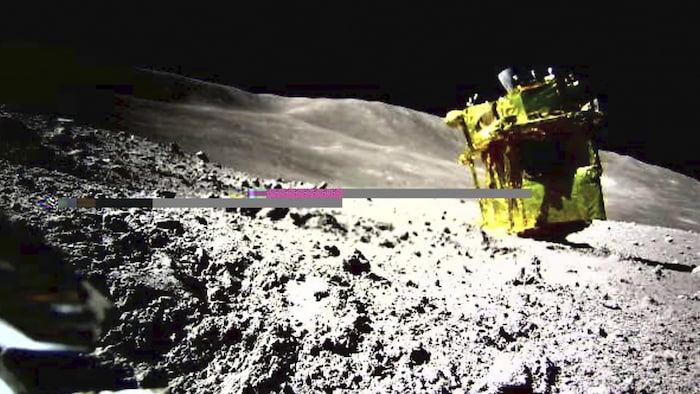Open in full screen mode The Japanese SLIM rover on the Moon. Image captured by one of the two cameras of Sora-Q, an ultra-compact robot (8 cm and 250 g). Agence France-Presse The small Japanese spacecraft SLIM which landed on the Moon last Friday touched down about 55 meters from its target, a very high degree of precision, announced the Japanese space agency (JAXA) . The objective of landing this module within a radius of 100 meters from its target, compared to several kilometers in general for missions lunar, was therefore achieved.
Mosaic image of the lunar surface captured by SLIM. The gray area to the right of the tile is missing data due to the scanning operation being interrupted.
JAXA also published on Thursday the first images of this moon landing, which represented an unprecedented feat for Japan, which became the fifth country in the world to successfully land on the Earth's natural satellite after the United States, the ;USSR, China and India.
But the Japanese feat was accompanied by a serious downside: SLIM (Smart Lander for Investigating Moon) experienced a problem with its solar panels, which forced JAXA to turn off its power supply for less than three hours after its moon landing, to save its batteries for a possible restart later.
JAXA believes that it is possible that the SLIM solar panels will work again when the angle of the sun at the moon landing site has changed.
Charging
Cardinal Lacroix and the Seminary of Quebec in turmoil
ELSEWHERE ON INFO: Cardinal Lacroix and the Seminary of Quebec in turmoil
SLIM landed in a small crater less than 300 meters in diameter, called Shioli, and was able to disembark normally its two mini astromobiles supposed to carry out analyzes of rocks coming from the internal structure of the Moon (the lunar mantle), which is still very poorly understood.
In 2022, a JAXA probe, Omotenashi, on board the American Artemis 1 mission, experienced a fatal battery failure shortly after its ejection into space.
And, in April 2023, a lunar lander from the Japanese company Ispace crashed on the surface of the Moon, having missed the smooth descent stage .
Reaching the Moon remains an immense technological challenge, even for the major space powers: the private American company Astrobotic, under contract with NASA , announced Thursday that its Peregrine moon landing device had been deliberately destroyed, probably disintegrating upon re-entering the Earth's atmosphere before reaching its objective.
NASA also postponed the next two missions of its major return to the Moon program, Artemis, by almost a year, to September 2025 and September 2026.

